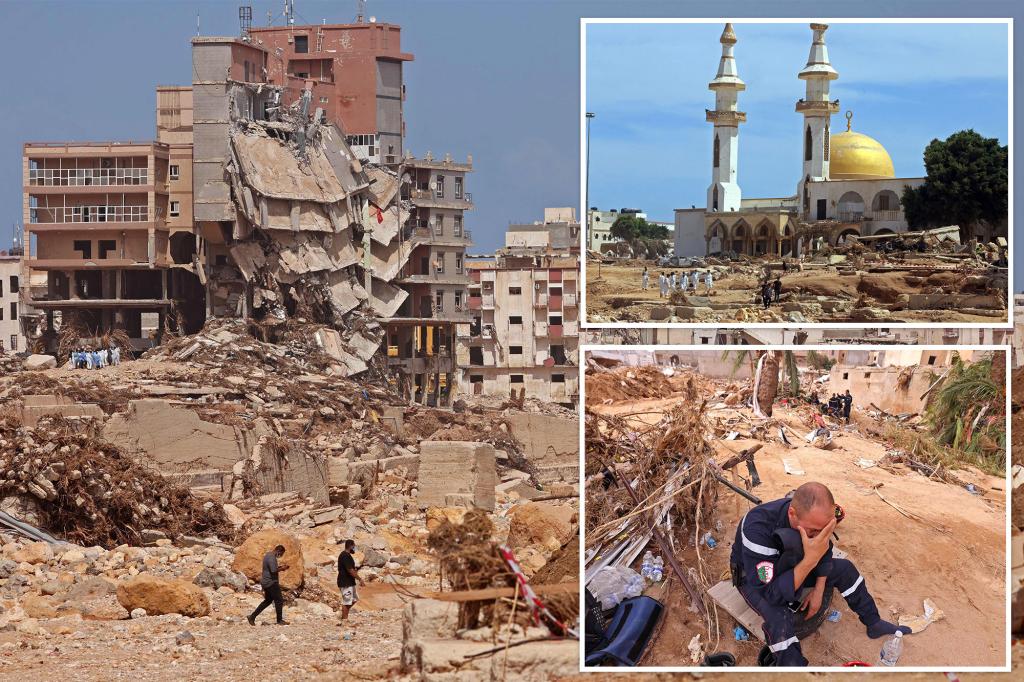More than 11,000 people have been killed by massive floods in Libya, with more than 10,000 still missing and survivors now facing the threat of water-borne diseases.
National and international rescue workers continued to sift through rubble for bodies after two major dams burst in the north African country yesterday, killing thousands and leaving 40,000 homeless, authorities said.
Health officials now fear that diseases arising from contaminated water could lead to another wave of deaths.
“You have a lot of standing water,” says Dr. Margaret Harris, spokeswoman for the World Health Organization. “It doesn’t mean the body poses a risk, but it means the water itself is contaminated by everything.
“So you really have to focus on making sure people have access to safe water,” Harris said.
Mediterranean storm Daniel caused chaos, with heavy rain breaking dams and sending walls of water two stories high raging in eastern Libya, with the worst damage in the port city of Derna.
 International aid organizations are scrambling to get supplies to survivors of last week’s massive floods in Libya.AFP via Getty Images
International aid organizations are scrambling to get supplies to survivors of last week’s massive floods in Libya.AFP via Getty Images
“The waves washed people away,” said survivor Adel Ayad. “We could see people being carried away by the floodwaters.”
Afterward, bodies “strewn the streets, washed back onto the beach and were buried under collapsed buildings and debris,” said Bilal Sablouh, regional forensic expert for Africa with the International Committee of the Red Cross.
“In just two hours, one of my colleagues counted more than 200 bodies on the beach near Derna,” he said.
 National and international rescue workers continue to sift through rubble in Libya following the massive failure of two dams in the country’s eastern region last week. Reuters
National and international rescue workers continue to sift through rubble in Libya following the massive failure of two dams in the country’s eastern region last week. Reuters
According to the Libyan Red Crescent, there were 11,300 dead in Derna as of Thursday, with another 10,100 still unaccounted for. The storm also killed about 170 in other parts of Libya, officials said.
Severe water shortages and lack of supplies for survivors are now a priority.
“We still don’t know anything,” said one survivor who identified himself only as Wasfi. “We heard rumours, some tried to convince us, others said you have to leave the city or stay here.
 International health officials say waterborne diseases pose a new threat following the catastrophic failure of two dams in Libya last week that left more than 11,000 dead and 40,000 homeless — with more than 10,000 still missing. AFP via Getty Images
International health officials say waterborne diseases pose a new threat following the catastrophic failure of two dams in Libya last week that left more than 11,000 dead and 40,000 homeless — with more than 10,000 still missing. AFP via Getty Images
 Rescue workers are still combing through rubble for bodies after more than 11,000 people were killed in Libya last week when two dams burst in Derna and washed away large areas of the African country’s east, with 10,000 missing.REUTERS
Rescue workers are still combing through rubble for bodies after more than 11,000 people were killed in Libya last week when two dams burst in Derna and washed away large areas of the African country’s east, with 10,000 missing.REUTERS
 Rescuers assist in relief work in the eastern Libyan city of Derna on September 17, 2023 following a deadly flash flood. AFP via Getty Images
Rescuers assist in relief work in the eastern Libyan city of Derna on September 17, 2023 following a deadly flash flood. AFP via Getty Images
“We have no water and no resources.”
The response to the devastating floods has brought remarkable unity to a politically divided country.
Libya has been divided by two warring political factions following the death of strongman Muammar Qaddafi in 2011, with both sides mired in civil war in recent years.
“Everyone wants to help,” said Manoelle Carton, medical coordinator for Doctors Without Borders. “But it was chaos. There is a great need for coordination.”
The flooding comes after another African disaster, when a massive earthquake hit Morocco last week, killing at least 2,000 people, according to authorities.
With Postal wire
Categories: Trending
Source: thtrangdai.edu.vn/en/



